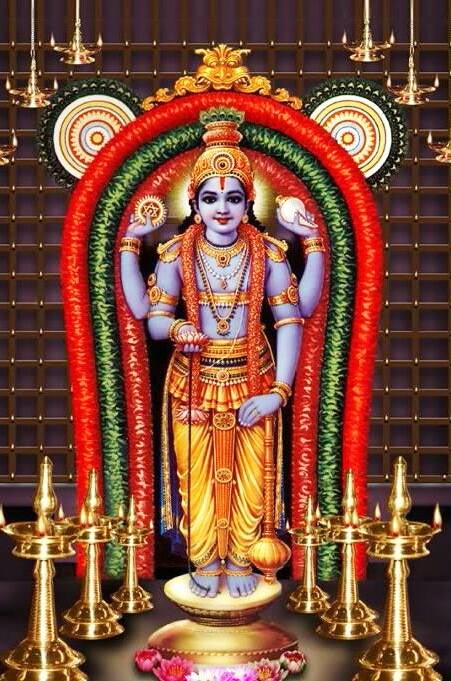Guruvayur and its importance
Guruvayoor, the abode of Lord Sree Guruvayoorappan, is located 29 kms north west to the cultural capital of the 'God's own country', Kerala. This narrow coastline strip of land on the south western edge of Indian subcontinent is one of the 10 paradises in the world.
Guruvayoor is a thriving township in Trichur district of Kerala state in the South of India, its scenic beauty and serenity are breath taking. Guruvayoorappan is the chief diety here - The God which hears the prayers of its pilgrims. Guruvayoorappan is adorned with the holy tulasi (Basil) garland, and pearl necklace the Lord here appears in all radiance to bless the devotees.
The square shaped Sree Kovil has two stairs and three rooms inside and has aninner room known as Garbhagriha. This is where the idol of Sree Krishna is placed. One can also find images of Ganapathy, Lord Ayyappa and Edathedathu Kavil Bhagavathy inside the temple. The healing powers of the shrine drive many to visit it in large numbers. Only Hindus are allowed inside the Temple.
Temple Timings:
Open 03:00 - 12:30 hrs & 16:30 - 21:15 hrs
Major Attractions
Udayasthamana Pooja: This is the most popular offering, the booking for which are said to have been done for the next ten years. Udayasthamaya literally means from sunrise to sunset. Hence it implies worship from sunrise to sunset. It consists of 15 special Poojas in addition to all the routine poojas and begins after the morning Siveli. There is a special feast for the devotees. There is the Vilakku (illumination) in the evening. The Siveli in the evening takes 5 rounds instead of the usual 3. The tripuka marks the end of the udayastamana pooja.
Prasadaootu: These are arrangements for free feeding as Prasadams at the dining hall for thousands of pilgrims at 10.00 AM everyday. One can make an offering of any amount (min Rs 1) for this free feeding.
Elephants: Devotees offer elephants to Guruvayoorappan and today there are about 40 elephants kept with Punnathur Kotta maintained by the Devaswam. The feeding of these elephants- Anayoottu is another popular offering that attracts many on-lookers. All the elephants are taken to the temple at around 10 A.M, and fed a sumptuous feast of fruits, molasses and boiled rice.
Tulabharam: A devotee is weighed against a commodity of his choice-banana, sugar, water, gold, in fact anything permitted inside the temple. If you want to be weighed against articles not permitted inside, do not worry. Arrangements are made for conducting the tulabharam outside the temple. Also, non-Hindus can perform the ritual outside.
Annaprasanam: This is the first rice-giving ceremony of a child conducted before the Lord Guruvayoorappa . All the itemsincluding cooked rice, payasam (sweet preparation of rice and jaggery; rice, sugar & milk) plantain etc. are placed on a banana leaf and the children are fed each of these.
Alroopams: You can offer miniature images in gold or silver, or replicas of different parts of the human body, eyes, nose, limbs etc. It is believed to cure whichever part is affected and therefore offered. You can place it after depositing in the hundi, an amount devised by you.
Picking up Kunnikkuru: You can offer this to develop your children’s intelligence and smartness. A handful of these seeds (Abrus precatorious) are picked up and dropped thrice in the vessel kept for the purpose and an amount desired by the devotee is deposited in the hundi. Bhagavati Azhal: 10 or 20 wicks soaked in oil are kept in a sheath of plantain tree and lighted before the goddess Bhagavati. It is done after deeparadhana and athazha pooja.
Sayanapradakshina: Also called angapradakshina, the devotee circumambulates the temple, rolling along the pradakshina path with his eyes closed and chanting the Lord’s name.
Bhajan: This offering is the most fruitful and spiritually elevating- it is the complete dedication of oneself to God. It is austere worship, the devotees forgetting their worldly worries and associating them maximum with whatever goes on within the temple-heavy bath in the temple pond, drinking water from its well and having the Prasadam as food. Married people are expected to observe strict brahmacharya (celibacy) during the bhajan. Apart from these main offerings, there are a variety of archanas, alankarams, and naivedyams that can be offered. A list of all these offerings and their rates is displayed at the counters on the northern side of the temple.
Bhagavati Azhal: 10 or 20 wicks soaked in oil are kept in a sheath of plantain tree and lighted before the goddess Bhagavati. It is done after deeparadhana and athazha Pooja.
Krishnanattam: Krishnanaattam, which is the most important art form of the temple, is performed in the temple as an offering. Devotees can offer this as a vazhipadu or offering on a payment of the prescribed amount. Each days performance believably yields a particular benefit to those making the offering.
